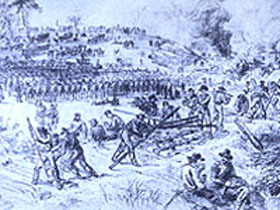 |
Civil War Battles |
|
State War Records |
| AL - AK - AZ - AR - CA - CO - CT - DE - FL - GA - HI - ID - IL - IN - IA - KS - KY - LA - MA - MD - ME - MI - MN - MS - MO - MT - NE - NV - NH - NJ - NM - NY - NC - ND - OH - OK - OR - PA - RI - SC - SD - TN - TX - UT - VT - VA - WA - WV - WI - WY |
The Battle of Staunton River
June 25, 1864 in Halifax County, Virginia
 |
|||||||||||||||||||||
|
When an urgent plea came from Benjamin Farinholt to come and assist his 296 Confederate reserves in defense of the Staunton River railroad bridge against an approaching Union cavalry force of over 5000 men, they came from every direction and all walks of life.
In June, General Robert E. Lee and his Army of Northern Virginia were engaged in a desperate defense of the city of Petersburg, Virginia. Victory for Lee depended upon a steady flow of supplies from the west and south, via the South Side and Richmond & Danville railroads. Maj. Gen. Ulysses S. Grant knew that if these supply lines could be destroyed, Lee would have to abandon Petersburg. To accomplish this, Grant planned a cavalry raid to tear up the tracks of both lines and destroy the Richmond & Danville railroad bridge over the Staunton River.
On June 22, the cavalry divisions of Brig. Gens. James Wilson and August Kautz were dispatched from the Petersburg lines to disrupt Confederate rail communications. They left Petersburg with over 5,000 cavalry troops and 16 pieces of artillery. As they moved west, the Union raiders were closely pursued by Confederate General W. H. F. "Rooney" Lee and his cavalry. Although Lee's troopers occasionally skirmished with the invaders, they were unable to stop their advance.
During the first 3 days of their raid, Wilson's cavalry tore up 60 miles of track and burned two trains and several railroad stations. Just south of Roanoke Station was a long, covered railroad bridge over the Staunton River, Wilson's final objective. The bridge was defended by a battalion of 296 Confederate reserves under the leadership of Capt. Benjamin Farinholt. Riding via Dinwiddie Court House, the raiders cut the South Side Railroad near Ford's Station that evening, destroying tracks, railroad buildings, and two supply trains.
On the 23rd, Capt. Farinholt received word from Lee that a large detachment of Union cavalry was moving his direction to destroy the bridge and that he should make every possible preparation immediately. Though his numbers had been bolstered by volunteers, Farinholt was still badly outnumbered. He had only 6 pieces of artillery, 4 in the earthwork fort on the hill just east of the bridge, and 2 in a small fortification west of the bridge. Between these artillery positions and the river was a line of trenches, and across the bridge lay a semicircular line of hastily constructed but well-concealed rifle trenches. Capt. James A. Hoyt with his 2 companies of regulars were on the east side of the bridge, and Col. Henry Eaton Coleman's "Old Men and Young Boys" were on the west side. Scouts and pickets were posted north of the bridge near Roanoke Station. Having arrived north of the bridge, Gen. Kautz's cavalry troops were dismounted and formed up to cross the open fields toward the bridge.
They were receiving heavy fire from the Confederate artillery on the other side of the river. Having finally reached a shallow drainage ditch some 150 yards north of the bridge, the Union troops organized for what was to be the first of 4 separate charges, all of them repulsed by the badly outnumbered Confederate forces. When the Union forces left the drainage ditch for their first assault on the bridge, they were met by intense fire from Col. Coleman's troops, who had been hidden from view in their shallow trenches around the bridge. Wilson proceeded to the junction of the Richmond & Danville Railroad at Burke Station, where he encountered elements of William H.F. Lee's cavalry between Nottoway Court House and Blacks and Whites. Wilson followed Kautz along the South Side Railroad, destroying about thirty miles of track as he advanced.
On the 24th, while Kautz remained skirmishing around Burkeville, Wilson crossed over to Meherrin Station on the Richmond & Danville and began destroying track.
On the 25th, Wilson and Kautz continued tearing up track south to the Staunton River Bridge, where they were delayed by Home Guards, who prevented destruction of the bridge. Lee's cavalry division closed on the Federals from the northeast, forcing them to abandon their attempts to capture and destroy the bridge.
By this time, the raiders were nearly 100 miles from Union lines.
